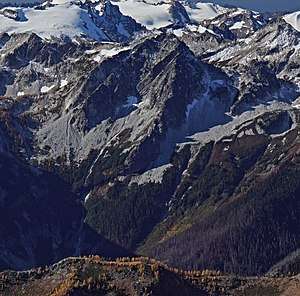Mount Berge
Mount Berge is a 7,960-foot (2,430-metre) double-summit granitic mountain located in the Glacier Peak Wilderness of the North Cascades, in Chelan County of Washington state. The mountain is situated along the crest of the Cascade Range, on land managed by Okanogan-Wenatchee National Forest. Its nearest higher neighbor is Napeequa Peak, 1.2 mi (1.9 km) to the west, and Buck Mountain is 1.7 mi (2.7 km) to the east-southeast. Berge is positioned on Chiwawa Ridge with Buck and Napeequa, and other notable peaks on this ridge include Fortress Mountain, Brahma Peak, Cirque Mountain, and Chiwawa Mountain. Precipitation runoff from Berge drains to the headwaters of Napeequa River; or east into tributaries of the Chiwawa River. This peak was named to remember Richard Waldo Berge (age 23) who perished while climbing Baring Mountain on July 16, 1952.[3] Berge was climbing with Fred Beckey at the time of the accident. Beckey's Cascade Alpine Guide credits Richard Berge wth several first ascents in the Cascades.
| Mount Berge | |
|---|---|
 Mt. Berge, east aspect, from Mount Maude | |
| Highest point | |
| Elevation | 7,960 ft (2,430 m) [1] |
| Prominence | 1,000 ft (300 m) [1] |
| Parent peak | Cirque Mountain (7,966 ft)[1] |
| Isolation | 1.2 mi (1.9 km) [2] |
| Coordinates | 48°06′12″N 120°56′46″W [1] |
| Geography | |
 Mount Berge Location in Washington  Mount Berge Location in the United States | |
| Location | Glacier Peak Wilderness Chelan County, Washington, U.S. |
| Parent range | North Cascades Cascade Range |
| Topo map | USGS Clark Mountain |
| Geology | |
| Age of rock | Cretaceous |
| Type of rock | Granodiorite |
| Climbing | |
| Easiest route | class 3 scrambling[2] |
Geology
The North Cascades features some of the most rugged topography in the Cascade Range with craggy peaks, ridges, and deep glacial valleys. Geological events occurring many years ago created the diverse topography and drastic elevation changes over the Cascade Range leading to various climate differences.
The history of the formation of the Cascade Mountains dates back millions of years ago to the late Eocene Epoch.[4] With the North American Plate overriding the Pacific Plate, episodes of volcanic igneous activity persisted.[4] In addition, small fragments of the oceanic and continental lithosphere called terranes created the North Cascades about 50 million years ago.[4] During the Pleistocene period dating back over two million years ago, glaciation advancing and retreating repeatedly scoured and shaped the landscape.[4] Glaciation was most prevalent approximately 18,000 years ago, and most valleys were ice-free by 12,000 years ago.[3] Uplift and faulting in combination with glaciation have been the dominant processes which have created the tall peaks and deep valleys of the North Cascades area.
Subduction and tectonic activity in the area began during the late cretaceous period, about 90 million years ago. Extensive volcanic activity began to take place in the oligocene, about 35 million years ago.[5] Glacier Peak, a stratovolcano that is 7.8 mi (12.6 km) west of Mount Berge, began forming in the mid-Pleistocene.[3] Due to Glacier Peak's proximity to Mount Berge, volcanic ash is common in the area.
Climate
Most weather fronts originate in the Pacific Ocean, and travel northeast toward the Cascade Mountains. As fronts approach the North Cascades, they are forced upward by the peaks of the Cascade Range, causing them to drop their moisture in the form of rain or snowfall onto the Cascades (Orographic lift). As a result, the west side of the North Cascades experiences high precipitation, especially during the winter months in the form of snowfall.[3] During winter months, weather is usually cloudy, but, due to high pressure systems over the Pacific Ocean that intensify during summer months, there is often little or no cloud cover during the summer.[3] Because of maritime influence, snow tends to be wet and heavy, resulting in high avalanche danger.[3]
References
- "Mount Berge, Washington". Peakbagger.com.
- ""Mount Berge" - 7,980' WA". listsofjohn.com. Retrieved 2020-06-09.
- Beckey, Fred W. Cascade Alpine Guide, Climbing and High Routes. Seattle, WA: Mountaineers Books, 2008.
- Kruckeberg, Arthur (1991). The Natural History of Puget Sound Country. University of Washington Press.
- "North Cascades Geology". United States Geological Survey. Archived from the original on August 1, 2013. Retrieved July 29, 2013.
External links
- Mount Berge aerial photo of east face: PBase
- Mount Berge aerial photo of upper east face: PBase
- Weather forecast: National Weather Service
- Richard Berge accident report: americanalpineclub.org
- Richard Waldo Berge death announcement: Newspapers.com